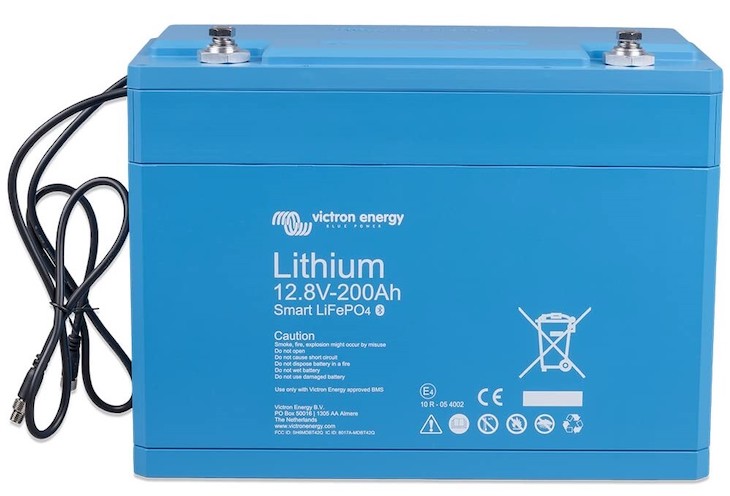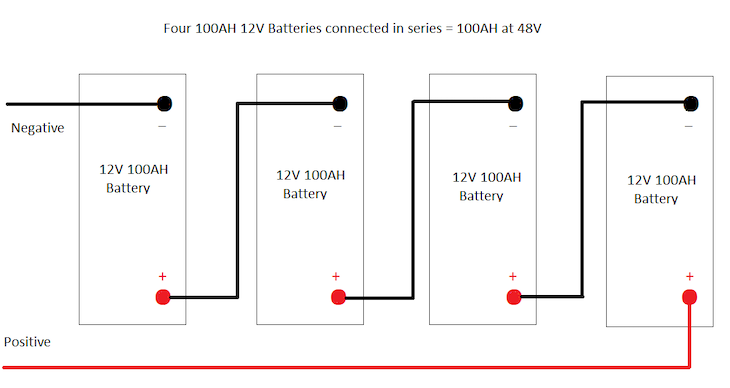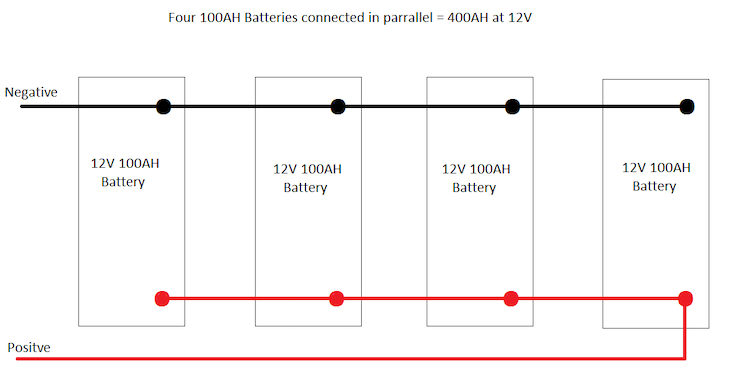In this information blog we will try and help you understand how to connect a battery bank together (i.e., more than one battery connected to another) in parallel or series, as both have very different outcomes regarding the voltage and capacity output from the battery bank.
Batteries are the primary source of DC power in most leisure vehicles. The size of the installation and power requirements will dictate the type and capacity of the battery configuration. The capacity of the battery is measured in Ampere’s hour (AH).
The larger the AH rating the more power available. (The measurement of an Ampere’s hour is how long the battery could power a single 1A device for in hours.)
The three most important things when selecting your battery are:
- Capacity in AH (Amp Hours)
- DOD rating (Depth of Discharge)
- Chemistry (i.e., lead acid, Lithium etc.)
We are not going to explain all the pros and cons of the different chemistries you can get today but it is something you need to be aware of when selecting your batteries.
All batteries have a DOD rating (Depth of Discharge). This rating refers to when the battery voltage drops to a level where the battery is considered discharged or flat.
Typically Lead acid batteries have a DOD of 50% (Please refer to battery manufacturer’s specifications for your specific battery) but in real world terms this means a 100AH lead acid battery has around 50AH of useable power before the battery is considered “flat” and is showing a voltage of below 11.9V DC.

A typical Lead Acid battery
Metal compound batteries, such as Lithium Iron/Lithium Phosphate have a DOD of 85-90% (Please refer to battery manufacturer’s specifications for your specific battery) but in real world terms this means a 100AH Lithium battery has around 85-90AH of useable power before the battery is considered “flat” and therefore you can use so much more power from the new Lithium style batteries.
Generally, Lithium batteries have an extra “interface” between the actual battery and the main battery terminals, which allows the battery terminals to keep a steady voltage right up to the point the battery is fully discharged.
Please note: some Lithium batteries are not suitable to connect into series or parallel so please make sure you have checked that your battery is compatible before connecting them this way.

A typical Lithium battery
Most batteries can be connected to increase battery capacity and / or voltage in the following ways:
- the system voltage can be increased by connecting batteries in series
- the battery capacity/current output can be increased by connecting batteries in parallel
Once you have created a battery bank you will need a compatible charger. This is fine if you’re keeping the voltage of the battery bank the same (parallel) as most battery chargers are designed to charge 12V batteries or battery banks with this voltage, but for a higher voltage bank of batteries in series you would need a charger that will charge the corresponding voltage.
If you’re connecting solar panels to charge your battery bank with either connection method, the solar panel array will need to be increased in size and / or voltage to charge the batteries efficiently.
Your solar charge controller will also need to be able to tolerate the higher voltages and currents required.
Installation recommendations
The batteries in the installation are best to be the same capacity and size, age and preferably the same brand.
The battery cable and battery links used will need to be of a sufficient size to handle the increased voltage or current, also the same cross-sectional area (CSA) and length. This will ensure that the batteries internal resistances and installation circuit impedances will be kept to a minimum.
Always use good quality battery terminals. Make sure all connections are tight, clean, and free from any corrosion.
Observing these installation recommendations will help in making sure each battery receives the same charge, and the battery voltage is balanced across the battery bank.
Batteries connected in Series
When connected in series the battery capacity will remain the noted capacity of one battery, only the voltage will increase. For example, two 12V 100AH batteries will give a total battery capacity 100Ahr at 24V. Four 12V 100AH batteries, give a total battery capacity of 100AH at 48V please see Fig. 1.

Figure 1: Four 12V 100AH batteries, connected in series
Batteries connected in Parallel

Figure 2: Four 12V 100AH batteries, connected in parallel
As always, we hope this simple information blog on connecting batteries together has been helpful. If you have any questions on any of this in regard to the SolarGo2 product range, please contact us and we will endeavour to help you out.
Kevin
